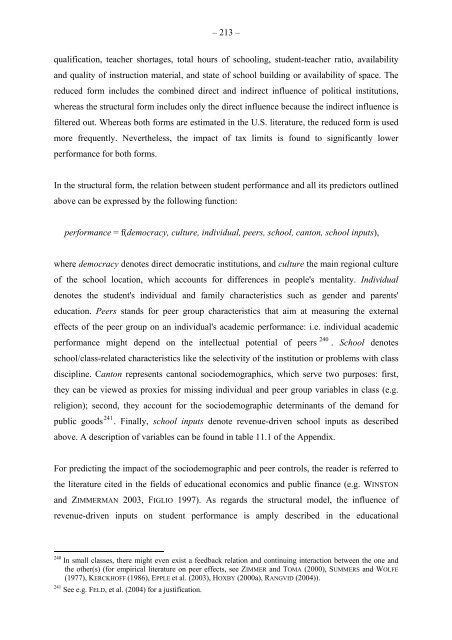The Impact of Direct Democracy on Society - Universität St.Gallen
The Impact of Direct Democracy on Society - Universität St.Gallen
The Impact of Direct Democracy on Society - Universität St.Gallen
- No tags were found...
You also want an ePaper? Increase the reach of your titles
YUMPU automatically turns print PDFs into web optimized ePapers that Google loves.
– 213 –qualificati<strong>on</strong>, teacher shortages, total hours <str<strong>on</strong>g>of</str<strong>on</strong>g> schooling, student-teacher ratio, availabilityand quality <str<strong>on</strong>g>of</str<strong>on</strong>g> instructi<strong>on</strong> material, and state <str<strong>on</strong>g>of</str<strong>on</strong>g> school building or availability <str<strong>on</strong>g>of</str<strong>on</strong>g> space. <str<strong>on</strong>g>The</str<strong>on</strong>g>reduced form includes the combined direct and indirect influence <str<strong>on</strong>g>of</str<strong>on</strong>g> political instituti<strong>on</strong>s,whereas the structural form includes <strong>on</strong>ly the direct influence because the indirect influence isfiltered out. Whereas both forms are estimated in the U.S. literature, the reduced form is usedmore frequently. Nevertheless, the impact <str<strong>on</strong>g>of</str<strong>on</strong>g> tax limits is found to significantly lowerperformance for both forms.In the structural form, the relati<strong>on</strong> between student performance and all its predictors outlinedabove can be expressed by the following functi<strong>on</strong>:performance = f(democracy, culture, individual, peers, school, cant<strong>on</strong>, school inputs),where democracy denotes direct democratic instituti<strong>on</strong>s, and culture the main regi<strong>on</strong>al culture<str<strong>on</strong>g>of</str<strong>on</strong>g> the school locati<strong>on</strong>, which accounts for differences in people's mentality. Individualdenotes the student's individual and family characteristics such as gender and parents'educati<strong>on</strong>. Peers stands for peer group characteristics that aim at measuring the externaleffects <str<strong>on</strong>g>of</str<strong>on</strong>g> the peer group <strong>on</strong> an individual's academic performance: i.e. individual academicperformance might depend <strong>on</strong> the intellectual potential <str<strong>on</strong>g>of</str<strong>on</strong>g> peers 240 . School denotesschool/class-related characteristics like the selectivity <str<strong>on</strong>g>of</str<strong>on</strong>g> the instituti<strong>on</strong> or problems with classdiscipline. Cant<strong>on</strong> represents cant<strong>on</strong>al sociodemographics, which serve two purposes: first,they can be viewed as proxies for missing individual and peer group variables in class (e.g.religi<strong>on</strong>); sec<strong>on</strong>d, they account for the sociodemographic determinants <str<strong>on</strong>g>of</str<strong>on</strong>g> the demand forpublic goods 241 . Finally, school inputs denote revenue-driven school inputs as describedabove. A descripti<strong>on</strong> <str<strong>on</strong>g>of</str<strong>on</strong>g> variables can be found in table 11.1 <str<strong>on</strong>g>of</str<strong>on</strong>g> the Appendix.For predicting the impact <str<strong>on</strong>g>of</str<strong>on</strong>g> the sociodemographic and peer c<strong>on</strong>trols, the reader is referred tothe literature cited in the fields <str<strong>on</strong>g>of</str<strong>on</strong>g> educati<strong>on</strong>al ec<strong>on</strong>omics and public finance (e.g. WINSTONand ZIMMERMAN 2003, FIGLIO 1997). As regards the structural model, the influence <str<strong>on</strong>g>of</str<strong>on</strong>g>revenue-driven inputs <strong>on</strong> student performance is amply described in the educati<strong>on</strong>al240 In small classes, there might even exist a feedback relati<strong>on</strong> and c<strong>on</strong>tinuing interacti<strong>on</strong> between the <strong>on</strong>e andthe other(s) (for empirical literature <strong>on</strong> peer effects, see ZIMMER and TOMA (2000), SUMMERS and WOLFE(1977), KERCKHOFF (1986), EPPLE et al. (2003), HOXBY (2000a), RANGVID (2004)).241 See e.g. FELD, et al. (2004) for a justificati<strong>on</strong>.
















